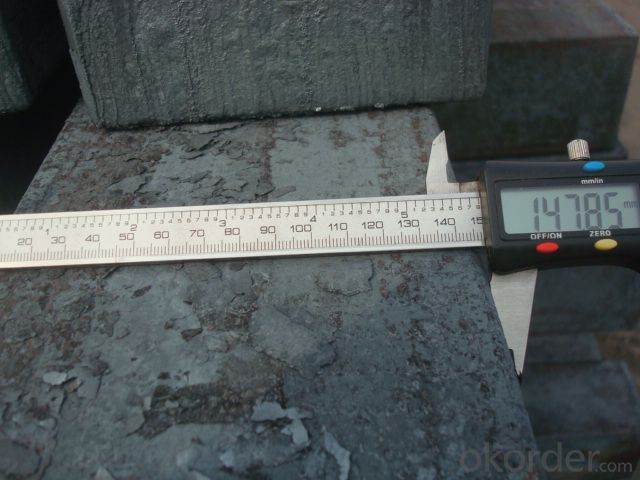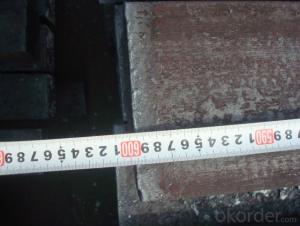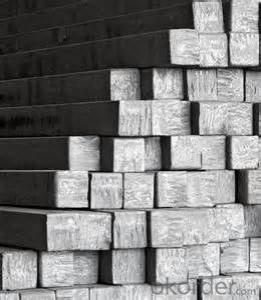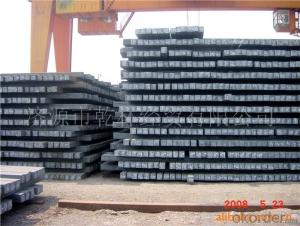Alloyed Steel Bloom/Billet Manufactured by Blast Furnace
- Loading Port:
- Tianjin
- Payment Terms:
- TT OR LC
- Min Order Qty:
- 1000 m.t.
- Supply Capability:
- 10000 m.t./month
OKorder Service Pledge
OKorder Financial Service
You Might Also Like
Alloyed Steel Bloom/Billet Manufactured by Blast Furnace
1.Structure of Alloyed Steel Bloom/Billet Manufactured by Blast Furnace
Steel Billets Manufactured by Continue Casting is the raw material of all kinds of steel mill. Billet section of square, round, flat, rectangular and abnormity, etc Several, mainly related to shape of rolled products. Simple rolled section steel, choose cross section of square billet or rectangular billet. rolling The sector products such as flat steel, Angle steel, select the rectangular billet or slab. Had better profiled billet when production beams, channels, and in rolling process Lines and improve the yield. The raw material of round billet is the production of seamless tube.
2.Main Features of Alloyed Steel Bloom/Billet Manufactured by Blast Furnace.
Steel Billets Manufactured by Continue Casting section size should meet the requirements of rolling deformation and finished product quality, but also roll strength and biting condition of restrictions. General steel Billet section height H. And the roll diameter D The ratio of the ( namely H/D) Should be less than or equal to zero 0.5 . Length of steel billet by finishing temperature, Rolling time and the length of the product Or times ruler. When heated too long accident prone to bump the furnace wall of steel, too short, furnace bottom utilization rate is not high, influence the heating furnace production. For the production Choose a variety of steel and steel billet, should consider the affinities of billet, as far as possible in order to improve the productivity of the roughing mill, simplify the stock management of workshop.
There are three shapes of the steel billets: square billet, slab, rectangular billet The Chinese billet, rectangular billet is mainly suitable for rolling hot rolled strip, building reinforced bar, Ordinary wire, high speed wire rod and various small profile. Of the slab are mainly used for rolling plate and hot coil sheet.
3. Alloyed Steel Bloom/Billet Manufactured by Blast Furnace Images


4. Alloyed Steel Bloom/Billet Manufactured by Blast Furnace Specification
Material standard The editor Range of thickness: 150-240 - mm + / - 5 mm width range: 880-1530 - mm + / - 20 mm Length: 3700-10000 - mm + / - 500 - mm Cross-sectional size: 64 * 64; 82 * 82; 98 * 98; 124 * 124; 120 * 150; 152 * 164; 152 * 170 mm Length: 9000 mm Section of tolerance: billet: 1.0 + / - 2.0-1.0 + / - 1.0 mm slab: width: + / - 2.0 mm thickness: + / - 3.0 mm The length tolerance: + / - 200 mm Section diagonal tolerance: 3.5-8.0 MM Billet section size protrusions requirements: < 1242 mm, do not allow; > = 1242 mm, < = 2 mm 1242 mm, < = 3 mm Beheading (shear) extension deformation: < 1242 mm billet: no control; The slab: < = 15 mm Surface tilt: no more than billet section 0.1 Bending: every 1 m length is not more than 10 mm The distortion: length < = 5 m, < = 11. ; The length of the < = 7.5 M, < = 5. Material % 3 sp/PS chemical composition: C Mn Si S P
5.FAQ of Alloyed Steel Bloom/Billet Manufactured by Blast Furnace
We have organized several common questions for our clients,may help you sincerely:
①How about your company?
A world class manufacturer & supplier of castings forging in carbon steel and alloy steel,is one of the large-scale professional investment casting production bases in China,consisting of both casting foundry forging and machining factory. Annually more than 8000 tons Precision casting and forging parts are exported to markets in Europe,America and Japan. OEM casting and forging service available according to customer’s requirements.
②What are the slab quality problem?
(1) of slab of purity (inclusion quantity, shape, distribution, etc.);(2) the surface of the casting defects (cracks, slag inclusion, porosity, etc.); (3) slab internal defects (cracks, segregation, inclusion, porosity and shrinkage cavity, etc.). Slab of purity depends mainly on molten steel into mold before processing, namely before pouring molten steel make "clean";Cast to the control process at the same time, don't let the inclusions with steel downward. Slab of purity control starts () electric furnace and converter smelting to refining outside the furnace, tundish metallurgy, protective casting and electromagnetic stirring process control of the whole process.
What are the types of non-metallic inclusions in continuous casting billet? The non-metallic inclusions in continuous casting billet, according to the generated methods can be divided into endogenous inclusions and exotic inclusions. Endogenous inclusions, mainly is pointed out that steel, ferroalloy products and pouring molten steel and air secondary oxidation in the process of product, such as aluminum oxide. Foreign inclusions, mainly to the inclusion of smelting and casting process, such as the erosion of ladle, tundish refractory, involved in the package of slag and protecting slag, shuikou washed residue, etc. The final solidification in continuous casting billet size, quantity and distribution of inclusions and is affected by the purity of molten steel in tundish, the impact of the mold injection flow depth and the movement state of the flow injection etc.For curved continuous caster, from intrados 1/4 thickness in inclusions have gathered phenomenon, this is a serious defect.Electromagnetic stirring can control the movement of molten steel in mould, and exclusion of inclusions, therefore we have to be serious study of the production of impurity and motion law.
③What is the advantage of the continue Casting steel billet comparing to the die casting steel billet?
Compared with die casting, continuous casting has the advantages of: 1. To simplify the Steel billet The production process 2. Improve the metal yield 3. Improve the quality of the billet 4. Reduces the steel worker's labor intensity 5. Save energy and reduce consumption
Steel billet is produced by the method of through three processes: It is through the steelmaking system of continuous casting equipment, directly by the molten steel pouring into billet; The second is the steelmaking system in the production of steel ingot casting billet through system of steel rolling rolling equipment or processing of steel semi-finished products; Three is the steelmaking system production of steel ingot by forging the semi-finished product processing equipment.
- Q: What are the main factors that determine the pricing strategy of steel billets manufacturers?
- The pricing strategy of steel billets manufacturers is influenced by several key factors. These factors play a crucial role in determining the pricing decisions made by manufacturers in the steel billets industry. 1. Raw Material Costs: The cost of raw materials, particularly iron ore and scrap metal, is a significant factor in determining the pricing strategy. Fluctuations in the cost of these materials can directly impact the overall production costs and, subsequently, the pricing of steel billets. 2. Production Capacity: The production capacity of a steel billets manufacturer influences the pricing strategy. Manufacturers with higher production capacity may be able to achieve economies of scale, resulting in lower production costs and potentially more competitive pricing. 3. Market Demand: The level of demand for steel billets in the market is an essential factor in pricing decisions. Higher demand often allows manufacturers to set higher prices, while lower demand may necessitate more competitive pricing strategies to attract customers. 4. Competition: The level of competition within the steel billets industry also plays a significant role in determining pricing strategies. Manufacturers must consider the pricing strategies of their competitors to ensure they remain competitive in the market. Factors such as market share, product differentiation, and branding can influence a manufacturer's ability to set prices. 5. Transportation and Logistics Costs: The cost of transporting raw materials and finished products can impact pricing decisions. Manufacturers located closer to raw material sources or major markets may have a cost advantage over those located further away. Transportation costs, including fuel prices, shipping fees, and infrastructure quality, can influence the final pricing strategy. 6. Government Regulations: Government regulations, such as import/export duties, taxes, and tariffs, can affect the pricing strategy of steel billets manufacturers. These regulations may impact the cost of raw materials or the ability to access certain markets, ultimately influencing pricing decisions. 7. Economic Factors: General economic conditions, including inflation rates, interest rates, and exchange rates, can impact the pricing strategy. Manufacturers need to consider these factors to ensure their prices remain competitive and reflect changes in the overall economic climate. Overall, the pricing strategy of steel billets manufacturers is a complex interplay of various factors, including raw material costs, production capacity, market demand, competition, transportation costs, government regulations, and economic factors. Manufacturers must carefully analyze these factors to determine a pricing strategy that maximizes profitability while remaining competitive in the market.
- Q: The form of carbon in carbon steels
- The solubility of carbon content when the iron carbon alloy than in the iron when the excess carbon can be in the form of carbide iron or elemental state (graphite) in alloy, which can form a series of carbide, Fe3C (cementite, 6.69%C) is a metastable phase, it is a compound complex structure gap. Graphite is a stable phase of iron carbon alloy with simple six - party structure. Fe3C has the potential to break down into iron and graphite stable phases, but the process is extremely slow at room temperature.
- Q: What are the common shapes of steel billets?
- Steel billets can come in a variety of shapes, depending on their intended use and manufacturing process. Some of the common shapes of steel billets include square, rectangular, round, and hexagonal. Square billets are often used for applications requiring stability and strength, such as construction materials and machinery parts. Rectangular billets, with their elongated shape, are commonly used for structural components in construction and engineering projects. Round billets are often used for manufacturing pipes, tubes, and other cylindrical objects. Hexagonal billets, with their six-sided shape, are frequently used in the production of hex nuts, bolts, and other fasteners. These different shapes provide versatility in meeting various industry requirements and applications.
- Q: What are the different surface defects found in tool steel billets?
- Some common surface defects found in tool steel billets include scale, cracks, pits, and surface decarburization. Scale refers to the formation of oxidation layers on the surface of the billet, often caused by exposure to high temperatures during processing. Cracks can occur due to improper cooling or excessive stress during forging. Pits are small depressions or cavities on the surface, which can be caused by impurities or improper handling. Surface decarburization is the loss of carbon at the surface, resulting in reduced hardness and wear resistance.
- Q: How are steel billets used in the manufacturing of springs?
- Steel billets are used in the manufacturing of springs by being heated and then forged or rolled into the desired shape and size. These billets serve as the raw material for producing high-quality springs, providing the necessary strength and durability required for various applications.
- Q: How do steel billets contribute to the overall weight reduction of a structure?
- Steel billets contribute to the overall weight reduction of a structure by being a lightweight and high-strength material. They allow for the design of thinner and more efficient structural elements, reducing the amount of steel required, and consequently the weight of the structure.
- Q: How do steel billets contribute to the manufacturing of construction supplies?
- Steel billets are the primary raw material used in the manufacturing of construction supplies. These billets are heated and then shaped into various forms such as bars, rods, beams, and plates, which are essential components in construction projects. They provide the necessary strength, durability, and structural integrity required for buildings, bridges, and other infrastructure. The versatility and quality of steel billets make them indispensable in the construction industry.
- Q: What is the role of steel billets in the construction of railway stations?
- Steel billets play a crucial role in the construction of railway stations as they are used to fabricate various structural components, such as beams, columns, and trusses. These components provide the necessary support and stability to the station infrastructure, ensuring the safety and durability of the building. Steel billets are also utilized in the construction of railway tracks, where they are transformed into rails, sleepers, and other track elements, enabling the smooth and efficient operation of trains.
- Q: What is the size and shape of steel billets?
- Steel billets come in various sizes and shapes, depending on the specific requirements of the manufacturing process. Typically, steel billets are rectangular or square in shape, with dimensions ranging from a few inches to several feet in length, width, and height. The exact size and shape of steel billets are determined by factors such as the type of steel being produced and the intended use of the billets in subsequent manufacturing processes.
- Q: What are the different methods of surface inspection for steel billets?
- There are several methods of surface inspection for steel billets, including visual inspection, magnetic particle inspection, ultrasonic testing, eddy current testing, and dye penetrant testing. Visual inspection involves a thorough visual examination of the billet's surface to detect any visible defects or irregularities. Magnetic particle inspection uses magnetic fields and iron particles to identify surface cracks or defects. Ultrasonic testing uses high-frequency sound waves to detect internal and surface flaws in the billet. Eddy current testing uses electromagnetic induction to detect surface defects, while dye penetrant testing involves applying a colored dye to the surface and inspecting it for any indications of defects. These methods help ensure the quality and integrity of steel billets before further processing or use.
Send your message to us
Alloyed Steel Bloom/Billet Manufactured by Blast Furnace
- Loading Port:
- Tianjin
- Payment Terms:
- TT OR LC
- Min Order Qty:
- 1000 m.t.
- Supply Capability:
- 10000 m.t./month
OKorder Service Pledge
OKorder Financial Service
Similar products
Hot products
Hot Searches
Related keywords

























